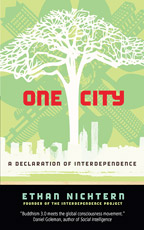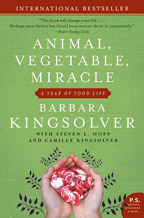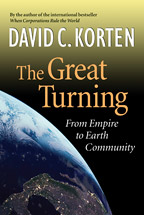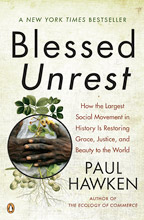One City:A Declaration of Interdependence
by Ethan Nichtern
Wisdom Publications 2007

Ethan Nichtern is the perfect guru for Generation Y. At 29, this hip dharma brat is a Buddhist teacher, author and podcaster of the weekly “21st Century Buddhism,” as well as the founder of the Interdependence Project, a non-profit community-oriented organization in New York City’s East Village based on meditation and Buddhist thought. His book One City takes an ultra-contemporary spin on ancient wisdom. It is a guide to navigating 21st-century fast-paced American city living for its Internet-surfing, video-game-playing, hip-hop-listening consumers.
His voice is fresh, straightforward and highly accessible, sometimes verging on the simplistic and reductive. He often draws on personal experience and uses examples his readers can relate to, from multinationals such as Reebok and Pepsi to iconic city landmarks such as Times Square. Nichtern is appealing to a very particular target audience: the youth of this fragmented world of ours who might normally dismiss Buddhism as too exotic, too difficult or too 1970s and he is pulling them in with lingo, imagery and cultural references that are familiar and easy to grasp.
The writing is certainly easy to digest, and this is no small feat. Nichtern manages to condense some of Buddhism’s complex metaphysical, philosophical and ethical issues into bite-sized pieces using language that is refreshingly comprehensible. This could be a very good thing: an ushering in of a new era in American Buddhism and a reflection of Nichtern as a no-nonsense teacher who can keep the disillusioned and easily distracted hipsters on their cushions for longer than a nanosecond. However, the book’s simplicity feels like both its powerful centre and its fatal flaw.
Call me a purist, but this kind of Buddhism makes me a little nervous. As a Gen-X Buddhist practitioner, maybe I just missed the boat for the audience Nichtern is appealing to. From where I sit it feels like this spoon-fed approach is directly linked with what is wrong with our society and with young minds; that we want everything now and we want it all to be easy. A key element to Buddhist thought in practice is the individual’s struggle to realize its essential wisdom. Here, Nichtern presents a very difficult practice in a form so easy to grasp it feels as if there is not much left to wrestle with.
A student in the Tibetan tradition under teacher Sakyong Mipham, Nichtern has formally been practising meditation since the age of 18, and he certainly does know his stuff. His opening chapter on the interdependence of all things through an examination of his daily routine is thoroughly thought-provoking and his chapters on non-violence and right livelihood are particularly strong and astute.
Nichtern’s teachings are non-dogmatic, straightforward and so secular they sometimes don’t feel like Buddhism at all. And perhaps this is the point: the book is fundamentally about interdependence, about living a more connected and aware life. The teachings he provides do have the potential to incite positive change in the world we live in and the way we live in it as global citizens — there is certainly no harm in that. What hangs in the balance is whether his teachings will have staying power. Will young people go the extra mile and stick with Buddhist meditation practices or stay committed to the fight for a world where interdependence becomes the foundation for a more enlightened society?
Nichtern is certainly a strong voice and leader for a new generation lost in the wilderness of pop culture and degraded values. Here’s hoping his vision runs deep enough to inspire true change.
— Talya Rubin
back to top
Animal, Vegetable, Miracle: A Year of Food Life
by Barbara Kingsolver, with Steven L. Hopp & Camille Kingsolver
Harpers Collins 2007

In my work, my colleagues and I talk about the disconnect we feel in our communities. Detached from the food we eat, removed from the decisions that guide us and separated from each other by the roads and buildings that surround us, we also talk of our loneliness and the isolation we feel from each other and the earth that sustains us. The paradox is that all of us are community developers and doing amazing work to better our cities.
Furthermore, my job at the Tamarack Institute contributes to global warming through the amount of travel I need to do, the hours I work effects my health and the way I live consumes far too many of the worlds resources.
That said, I truly love what I do and feel like I am contributing to building a better world. When I teach, I often talk about systems that connect and sustain people, ways to work better together and of the physical infrastructure that both contains and enables us to live together. Much of the work is outward: the things we can do to improve our communities.
In Animal, Vegetable, Miracle: A Year of Food Life, Barbara Kingsolver teams up with her family to write about their move from Tucson, Arizona to their summer farm in the Appalachia. Their destination was to “live in a place that could feed us: where rain falls, crops grow and drinking water bubbles right up out of the ground.”
The story, as described by Kingsolver, “is pegged to a one year cycle of how and when foods become available in a temperate climate. We hoped to prove — at least to ourselves — that a family living on or near green land need not depend for its life on industrial food.” This one year cycle follows the twists and turns of preparing the land, growing and then processing food.
Kingsolver and her family struggle to connect with a new way of living and their efforts teach us about the land and the people who farm it. They make a commitment to heal themselves from the industrialization of food toward that which brings life. I resonated with this not only because I am a farm boy who moved to the city, but because the story is about a journey to find a better way in this chaotic world.
What makes this book so compelling for me is the tension Kingsolver describes between the urbanization of food and the fragmentation of how we live. Food often travels hundreds of miles to get to our tables and we have no knowledge or understanding of how that food was created. Growing up in a small cloistered Mennonite community, I was taught to be in the world but not of this world. I rejected this philosophy because I believed that to impact this world and create a better place for those disenfranchised, I need to be fully present — to show up every day!
My journey to go local is leading me back to my roots but in a different way. I want to be in the world and I want to be connected to it. I do though want to live differently — seeking ways to not be part of that which destroys my soul my body and my mind. I do not know where this may lead but after reading Barbara Kingsolver I am inspired to start.
— Paul Born
back to top
The Great Turning: From Empire to Earth Community
by David C. Korten
Berrett-Koehler Publishers and Kumarian Press 2006
 The work of waking up includes recognizing that most of the stories we believed about ourselves aren’t true. This can be painful but it’s compensated by the meaning that emerges from aligning with purpose and potential. This process holds true for our collective waking. To mature as a global community requires that we let go of the narratives that perpetuate false promise and identity.
The work of waking up includes recognizing that most of the stories we believed about ourselves aren’t true. This can be painful but it’s compensated by the meaning that emerges from aligning with purpose and potential. This process holds true for our collective waking. To mature as a global community requires that we let go of the narratives that perpetuate false promise and identity.
One of Korten’s many gifts in The Great Turning is this exposition of false stories (stories that uphold a path of destruction, violence and oppression) for what they are, a collectively reinforced lie that promises security and happiness and delivers anything but. He not only exposes the lie but gives a framework in which to understand how these stories have directed us on a suicidal path.
“The Great Turning” is the term that describes our opportunity to turn from the way our human societies currently function, a way characterized by competition, hierarchical control and violence (termed Empire by Korten), to a way of social interaction that is cooperative and partnership-based (termed Earth Community). Our alternative will be what Korten calls The Great Unraveling, an experiment that will not be successful.
Current global indicators of crisis
— environmental degradation, war, terrorism, poverty, corporate dominance, erosion of family and community — have resulted in numerous incredulous voices that ask about governments, armies, corporations, individuals: “How could they?” “Why?” “What kind of people are these?” Incomprehensible decisions that bring profit to a few and cause suffering, poverty and loss to the many are hard to understand. Without understanding, how can we mobilize to resist their power, control and advance?
Here, Korten offers another gift: a context to understand and thereby have knowledge to act. He analyzes the growth of Empire historically and also places its capacity to control and shape human choices in a context of psychological and social growth. His examinations are a lesson in studying the enemy. The incomprehensible becomes embedded in a worldview that can be challenged, turned away from and weakened.
We’re ready for real democracy, which Korten refers to as the audacious experiment that never quite evolved from the “vision of possibility” that the ancient Greeks and patriots of the American Revolution attempted to birth. We may in fact now have the conditions to allow true democracy to unfold. We now have a means to communicate with each other on a global scale, bypassing reliance on traditional and slower forms of mass communication, which in general operate through the mentality and control of the false story model.
The Great Turning is encouraging, in spite of our precarious situation. Korten offers three reminders to avoid overwhelm: tens, maybe even hundreds, of millions of people are engaged in this work of Earth Community; every contribution, no matter how small, helps shift the balance; and we each can do no more than our individual best.
It’s been said that we are the ones we have been waiting for. This time it might be true.
— Alanda Greene
back to top
The Geography of Hope: A Tour of the World We Need
by Chris Turner
Random House 2007

By now, everyone knows that climate change is not only bad, real bad, but it’s our fault, gluttons that we all are.
These were the kinds of defeatist and timid attitudes that got award-winning journalist Chris Turner thinking about the future, particularly the one belonging to his newborn daughter. Especially when the environmental call to action was dominated by old-school eco-warriors, spouting the same kind of doom and gloom sales pitch he used as a Greenpeace canvasser during his university years.
His response was simple — find those great stories, those myths-in-the-making, and kickstart an epidemic of exuberance. “Anything that exists is possible,” writes Turner, a Wizard of Oz- like mantra that is the unlikely underpinning of Geography of Hope: A tour of the world we need. This ambitious and compelling travelogue visits the hotspots of sustainability, from a virtually carbon-neutral island off the coast of Denmark to a tiny hydro-electric power plant built by villagers in Thailand and many points in between.
Turner often writes at a fevered pitch, giddy with the recognition that there is a hell of a lot that is right going on in the world. Looking for a solution to suburban sprawl? Meet the guys who redeveloped a failed mall into a 22-block downtown core outside of Denver. What about barely breathable urban India? Take a tour of a building so green in Hyderabad, it even outranked any found in the West.
The style works: by leaving behind the self-loathing of exhausted activists for tales of entrepreneurship in the strangest places, Turner recreates that palpable sense of wonder and possibility that was the trademark of the dotcom era (minus the burst bubble), a subject he mastered at the now-defunct technology magazine, Shift. From technology to development, all the big themes get the search for hope treatment with a few idiosyncratic tangents through pop culture.
The urgency of the writing occasionally falters when Turner leaves reportage behind. For example, he repeatedly references Rachel Carson’s Silent Spring, but never provides a nuanced examination of her work. E. F. Schumacher’s 1973 classic, Small is Beautiful, which questioned the assumption of unending economic growth, receives a better treatment; however, Turner fails to discuss the publication a year earlier of Limits to Growth by the Club of Rome.
So what about the twin pariahs of big business and consumers? Voila, Amory Lovins (Natural Capitalism), the mass-market saviour who takes Schumacher’s ideas to Wal-mart to find ways to lower carbon emissions while improving the bottom line. Turner may value the livable and small scale over the grand scheme as he goes through thinkers such as Jane Jacobs, Vandana Shiva and Muhammed Yunus; he is also canny enough to realize we are not abandoning grocery chains just yet.
What takes Geography of Hope beyond its counterparts, such as the George Monbiot diatribe, Heat, is the understanding that without community engagement, neither technology nor good intentions alone hold the keys for real change. Turner may be on to something: we can be “the generation that beat climate change,” because as he shows over and over again, anything that exists is possible.
— Piali Roy
back to top
Blessed Unrest
by Paul Hawken
Viking New York 2007

Paul Hawken has been a visionary of alternative economics and renewable resource use since the publication of The Next Economy in 1983. He is a pioneer and a specialist in the field of sustainability: sustainable land practices, sustainable business practices, and sustainability in the realm of how humans treat one another.
In his latest book, he lays out the histories of the environmentalism and social justice movements, complete with footnotes and bibliography. A third of the book is a guide to an online database that Hawken’s Natural Capital Institute has assembled. Hawken calls these one hundred pages “the most complete listing of issues that need to be addressed to achieve a just and sustainable world.”
Sounds a bit dry? But wait — what this book is really about is the largest social movement in all of history, happening right now, involving millions of people who are dedicated to change. These people are diverse, but they are all working to redress wrongs, to reform, restore, rebuild, and recover the systems we live with, and to reimagine the world. They are working locally, constructively, compassionately, without centralized leadership or a core dogma. Hawken calls this movement a collective response on the part of humanity to the threat of our planet’s ecological degradation and the social injustice that we have sowed and are reaping at this time. He calls it an immune system response.
Hawken’s writing is clear and lively; his statements are bold, yet backed by facts — and above all, he is optimistic. Do you ever get the feeling that maybe what you do just doesn’t matter? That you are a drop in a bucket? Are you wondering how you fit in to the greater whole, how you can contribute or be responsible? Maybe you’re wondering how military or financial superpowers will be dismantled or whether education is really making a difference.
Blessed Unrest describes how this movement is differentiated from previous social revolutions. The author shows how small steps taken against exploitation, corruption, war, and poverty “make the road by walking,” relieving the plight of that majority of human beings known as “the minorities.” He details our realization that everything on this earth — living and otherwise — is intertwined, and explains why this idea, though at last almost universally recognized, is not universally acted on. He lights up the connection between ecology and morality, and shows how indigenous cultures are the quiet hub of true civilization, which he defines as the ability to live well within the biological constraints of the earth.
Most satisfying of all, this book gives that rare and thrilling feeling: that at last someone is articulating, both passionately and coherently, a complex of good ideas that you have felt stirring like spring sap in your roots — but never been able to put your finger on it, or words to it.
— Romana Prokopiw
back to top